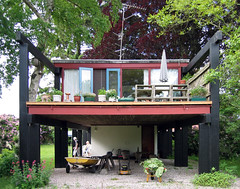- in Green Home by Alexis Rodrigo
Zero-Carbon Houses
Can you imagine what it would be like to live in a house that produced zero carbon emissions? It’s almost inconceivable, right? How could that work? Let’s take a look at what it means to be a zero-carbon house and how it’s possible.
Definition of Zero-Carbon
Designed to drastically reduce our greenhouse emissions by utilizing more efficient and sustainable practices, zero-carbon homes and buildings are being designed and built all around the world. Depending on whom you ask, zero-carbon has different meanings. It’s defined by the country and by the professional. For example, an architect may define zero carbon differently than a civil engineer.
Here are some common definitions:
*Zero-carbon is a general term applied to a building with zero net energy consumption and zero carbon emissions annually. They’re separate from the energy grid and are also called off the grid homes.
*A zero carbon home is one that generates as much power as it uses over the course of a year and therefore has net zero carbon dioxide emissions. This is also commonly called a net zero site energy.
*Net off-site zero energy use is when a home produces 100% of the energy from renewable energy sources.
*Finally, another common definition is what is called net zero emissions, which means the carbon emissions generated from this type of home are balanced by the on-site energy production. For example, if the home uses 100 energy units from fuels and generates 100 units onsite from solar energy, then they?re net zero.
Each definition embraces a philosophy of what it means to be green. It taps into the energy conservation versus energy generation debate. Is a home green because it conserves energy or is it green because it generates its own energy?
What Zero Carbon Means for You
Under these definitions, it’s entirely possible for you to transform your home into a zero-carbon home right now. Embracing wind and solar power to balance the amount of energy you use from the grid would result in a net zero off-site home. You’re contributing as much as you’re using. This is certainly something to keep in mind as you make modifications or undergo any type of home renovations.
Homebuilders today are adopting zero carbon practices to make their homes more environmentally friendly and to meet the demands of homebuyers. And if you’re going to be in the market to buy a home in the future, you can know what your energy options are. You can make an educated decision on where you get your energy resources and how you want to contribute to a greener planet.
There are of course benefits to having a zero-carbon home beyond reducing your carbon emissions. One substantial benefit is that while it may cost more to build a zero-carbon home, you do reap the benefits in substantially lower utility bills and after a few years will see your return on investment. Additionally, your home may retain or increase its value compared to comparable homes without an environmentally-friendly design.
![]() photo credit: seier+seier+seier
photo credit: seier+seier+seier
If you liked this post, submit your email address below to get new posts by email:

